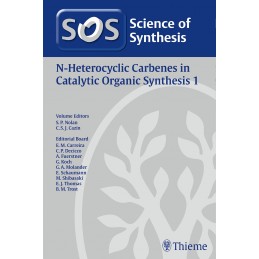- Obniżka


 Dostawa
Dostawa
Wybierz Paczkomat Inpost, Orlen Paczkę, DHL, DPD, Pocztę, email (dla ebooków). Kliknij po więcej
 Płatność
Płatność
Zapłać szybkim przelewem, kartą płatniczą lub za pobraniem. Kliknij po więcej szczegółów
 Zwroty
Zwroty
Jeżeli jesteś konsumentem możesz zwrócić towar w ciągu 14 dni*. Kliknij po więcej szczegółów
The field of N-heterocyclic carbenes, whether in transition-metal catalysis or organocatalysis, is rapidly evolving towards applications, but is also still very active on the catalyst development front. Significant advances have been made over the past two decades and the development of these reactions has dramatically improved the efficiency of organic synthesis. N-Heterocyclic carbene based catalysts are now widely applied in the area of synthesis of both natural products and therapeutic agents. Science of Synthesis:: N-Heterocyclic Carbenes in Catalytic Organic Synthesis presents the most commonly used and significant metal- or non-metal-catalyzed reactions for modern organic synthesis. The basic principles and current state-of-the-art of the methods are covered. Scope, limitations, and mechanism of these reactions are discussed and key experimental procedures are included. Typical examples of target synthesis are often provided to show the utility and inspire further applications.
Opis
1.1 Introduction to N-Heterocyclic Carbenes
1.1.1 Historic Perspectives on Carbenes
1.1.2 Types of N-Heterocyclic Carbenes
1.1.3 Synthesis of N-Heterocyclic Carbenes and Their Precursors
1.1.4 Synthesis of N-Heterocyclic Carbene Complexes
1.1.5 Quantifying Steric and Electronic Properties of N-Heterocyclic Carbenes
1.2 Cross Coupling
1.2.1 Suzuki-Miyaura Coupling
1.2.2 Cross-Coupling Reactions Other Than Suzuki-Miyaura Coupling
1.2.3 The Buchwald-Hartwig Reaction
1.2.4 C—O, C—S, and C—B Bond Formation
1.3 C—H Bond Functionalization
1.4 Addition Reactions
1.4.1 Hydrogenation
1.4.2 Transfer Hydrogenation
1.4.3 Hydrosilylation
1.4.4 Catalytic Boron Addition Reactions
1.4.5 Hydroamination
1.4.6 Hydrothiolation, Hydroalkoxylation, and Hydroaryloxylation
1.4.7 Hydration
1.4.8 Hydroarylation
1.4.9 Chloroacylation and Chloroalkoxycarbonylation of Alkynes
1.4.10 Hydroformylation
1.4.11 Hydroaminomethylation
Indeks: 78152
Autor: Dholakia Shamik
